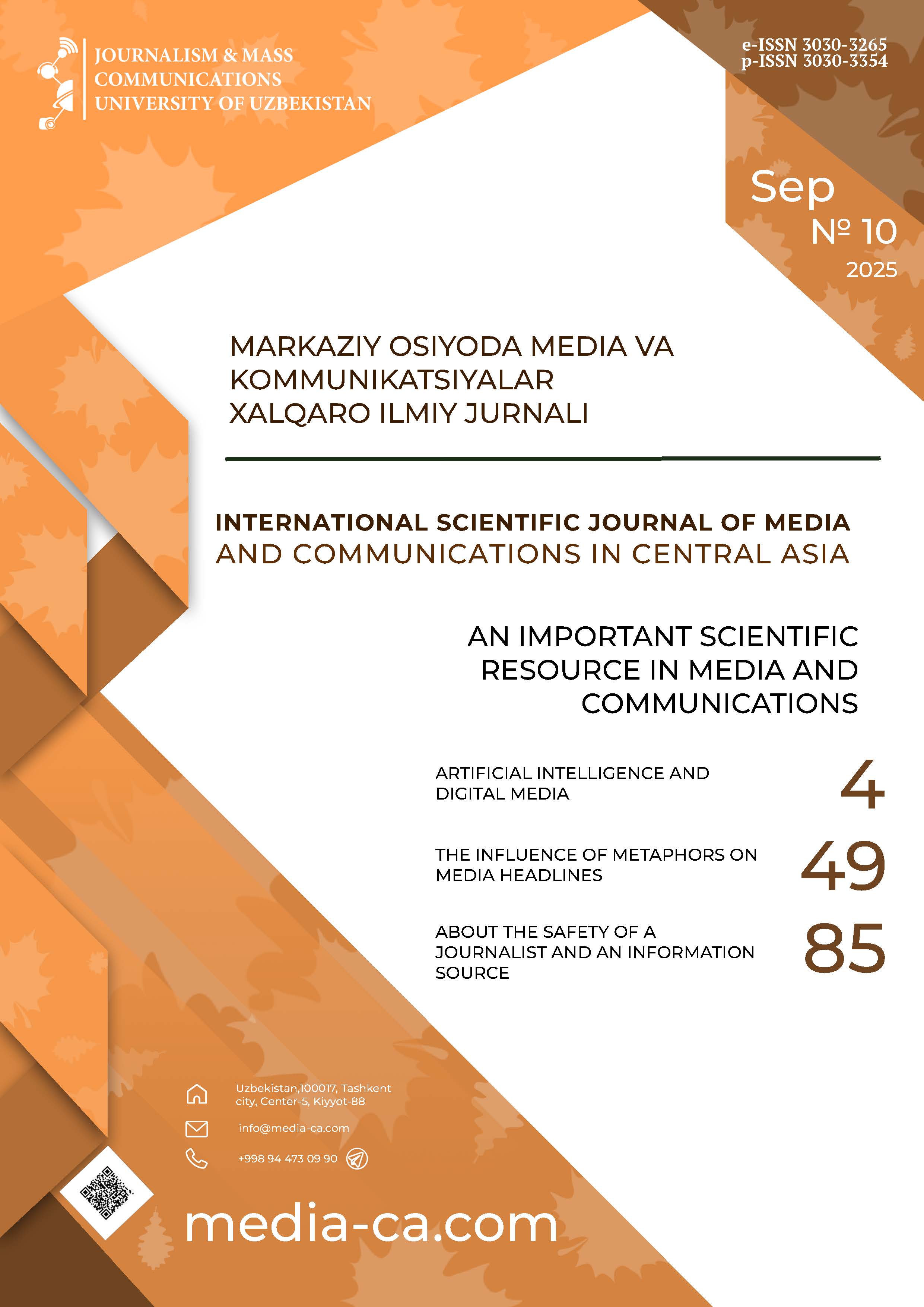Published 2025-07-21
Keywords
- children,
- cartoons,
- content,
- social networks,
- media
- parents ...More
How to Cite
Abstract
This article analyzes the quality of content designed for children in Uzbekistan’s media sphere. The study examines whether the materials produced for children are educationally and morally appropriate and age-relevant. The main research question is: “What is the quality of children’s content in Uzbek media, and does it meet their age, needs, and upbringing?” The research employed qualitative methods, including observation and content analysis. An online survey involving nearly 50 parents was conducted to identify the key needs of the children’s audience and the types of content they consume. The content analysis revealed a lack of children’s materials in the Uzbek language, the dominance of foreign content, and the scarcity of local characters. The study concludes that there is a pressing need to develop a dedicated media space for children in Uzbekistan.
References
- Bolalar uchun kontent yaratuvchi yuridik shaxslar foyda solig‘idan ozod qilinadi. (2025). Retrieved 22 July, 2025 from https://www.gazeta.uz/oz/2025/05/18/childrens-content/
- Mirzayeva, N. (2023). Bolalar nashrlarida kommunikativ va kontekstual o‘ ziga xosliklar. “Javohir-ilm-nashr”.
- «Bolalarimizni faqat chet el mediamahsulotlari bilan katta qilayotganimiz yetar» - Allamjonov bolalar kontentidan reklama taqiqini olib tashlashni so‘radi. (2021). Retrieved 22 July, 2025 from https://search.app/FAomqPnKnBf4EvHg8
- Bondi B.C., Tassone V.K., Bucsea O., Desrocher M. and Pepler D.J. (2025). A Systematic Review of Neurodevelopmental Assessments in Infancy and Early Childhood: Developing a Conceptual Framework, Repository of Measures, and Clinical Recommendations. Springer Science +Business Media, LLC, part of Springer Nature 2024. https://doi.org/10.1007/s11065-024-09641-7
- Calvert, S. L. (2015). Children and digital media. In M. H. Bornstein, T. Leventhal, & R. M. Lerner (Eds.), Handbook of child psychology and developmental science: Ecological settings and processes (7th ed., pp. 375–415). John Wiley & Sons, Inc.. https://doi.org/10.1002/9781118963418.childpsy410
- de Andrade F. R., Gilbert N., Velasquez C.T., Bégin V., Garon-Carrier G. and Fitzpatrick C. (2025). Child Exposure to Violent Content and Aggression: A Novel Approach to an Old Debate Running title: Child Exposure to Violent Content and Aggression, Academic Pediatrics. Journal Pre-proof. DOI: 10.1016/j.acap.2025.102879
- Espejo L., Perez N., Mendoza C., Gagarín Y. (2024). A Systematic Review on Unique Characteristics of Generation Z and Their Impact on Purchasing Decisions. Journal of Ecohumanism. Volume: 4, No: 1, pp. 12 – 25. DOI: https://doi.org/10.62754/joe.v4i1.4079
- Ghilzai S.A., Alam R., Soomro Z.A. (2017). Impact of Cartoon Programs on Children's Language and Behavior. Insights in language society and culture. Vol. 2 (201). pp. 104-126. Retrieved 22 July, 2025 from https://www.researchgate.net/publication/323523698_Impact_of_Cartoon_Programs_on_Children's_Language_and_Behavior
- Gülten Z. (2023). An Examination of Research on Cartoons and Value Education Using Systematic. International Journal of Educational Spectrum (IJES), Volume: 5 - Issue: 2, pp. 114-132. DOI: 10.47806/ijesacademic.1220396
- Habib, K, Soliman, T. (2015). Cartoons’ Effect in Changing Children Mental Response and Behavior. Open Journal of Social Sciences 3. pp. 248-264. http://dx.doi.org/10.4236/jss.2015.39033
- Henderson D, Bailes T, Sturza J, Robb MB, Radesky JS and Munzer TG (2024) YouTube for young children: what are infants and toddlers watching on the most popular video-sharing app? Front. Dev. Psychol. 2:1335922. doi: 10.3389/fdpys.2024.1335922
- Höfrova A., Balidemaj V., Small M.A. (2024). A systematic literature review of education for Generation Alpha. Discover Education. 3:125. https://doi.org/10.1007/s44217-024-00218-3
- Kabadayi A. (2024). From screen to skills: investigating cartoons' influence on preschoolers’ development. Distance Education in Ukraine: Innovative, Normative-legal, Pedagogical Aspects. Vol.1. (4). pp. 17-24. DOI: https://doi.org/10.18372/2786-5495.1.18876
- Martín-Critikián, D., y Medina-Núñez, M. (2021). Redes sociales y la adicción al like de la generación z. Revista de Comunicación y Salud, 11, 55-76. https://doi.org/10.35669/rcys.2021.11.e281l
- Matyoqubov A. (2025). Bizning bolajonlar xorijiy kontentlar bilan “ozuqlanish”ga majbur. (2025). Retrieved 22 July, 2025 from https://search.app/zVo3SwFNtDT6rT3n7
- O‘zbekistondagi “Aqlvoy” bolalar telekanalida behayo kadrlar efirga uzatilgani sabab butun telekanal ijodkorlari tanbeh oldi. (2021). Retrieved 22 July, 2025 from https://search.app/q96Sw7hcngH5HTYA6
- Sakhaei S., Sarabi A.S., Alinouri S. (2023). Media Literacy for Children: A Systematic Review. Journal of Cyberspace Studies. Volume 7, Issue 2. pp 277-298. https://doi.org/10.22059/jcss.2023.101606
- Sheikh M.A., Hassan A.A.U., Mohsin N., Mir B. (2023). Cartoon’s Content and their Impact on Children’s Psychology. Pakistan Journal of Humanities and Social Sciences. Volume 11 (4) pp. 3913-3923. DOI: https://doi.org/10.52131/pjhss.2023.1104.0660
- Topan A., Karakaya A.G., Akkoç B., Kurt A.. (2025). Children's social media use behaviors according to parents' social media addiction and methods used by parents. Journal of Pediatric Nursing.Volume 84, pp. 347-352. https://doi.org/10.1016/j.pedn.2025.06.046. Retrieved 22 July, 2025 from https://www.sciencedirect.com/science/article/pii/S0882596325002295.
- Zoromba M.A., Doaa A., Hashem S., El-Gazar H., Magda A. A. E. A. (2023). Association between media exposure and behavioral problems among preschool children. Frontiers in Psychology. Volume 14. Pp 1-8. DOI:10.3389/fpsyg.2023.1080550
- Светловская, Н. Н. (1999). Обучение детей чтению: Детская книга и детское чтение. Учеб. пособие для студ. высш. пед. учеб. Заведений. Москва. AcademiA, 244 с. ISBN 5-7695-0416-1 (в пер.). Доступ 22 июля, 2025 по ссылке https://library.omgpu.ru/node/3305

